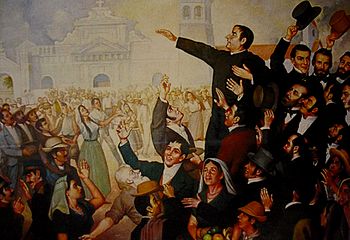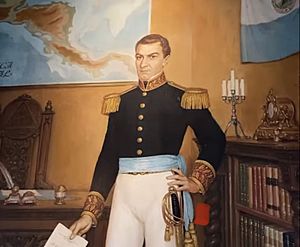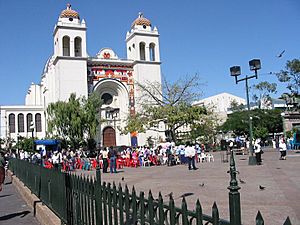1811 Independence Movement facts for kids
Quick facts for kids 1811 Independence Movement |
|||||||
|---|---|---|---|---|---|---|---|
| Part of the Spanish American wars of independence | |||||||
 Painting of the First Shout of Independence |
|||||||
|
|||||||
| Belligerents | |||||||
| Salvadoran revolutionaries | |||||||
| Commanders and leaders | |||||||
| José Matías Delgado Manuel José Arce Santiago José Celis Juan Manuel Rodríguez |
|||||||
| Strength | |||||||
| Unknown | 400 | ||||||
The 1811 Independence Movement is also known as the First Shout of Independence in El Salvador. It was the very first major uprising in Central America against Spanish rule. This important event happened in what is now El Salvador.
Leaders like José Matías Delgado, Manuel José Arce, and Santiago José Celis guided this movement. It was a big step towards Central American countries becoming independent from Spain.
Contents
Why People Wanted Independence
At the start of the 1800s, many people in Spanish-controlled lands in America were getting restless. They wanted more freedom. Ideas about individual freedom, which came from the Enlightenment in Europe, were spreading.
Two big events inspired them:
- The American Revolution, where the British colonies became free.
- The French Revolution, which sparked ideas of freedom everywhere.
In San Salvador, a Spanish official named Antonio Gutiérrez y Ulloa became the leader in 1805. Many people didn't like him. They found him difficult to work with.
Many local people, especially those born in America but of Spanish descent (called Creoles), wanted San Salvador to be separate from the main Spanish government in Guatemala. They had two main reasons:
- Money: They wanted to pay less in taxes to Spain and Guatemala.
- Power: They wanted more control over their own government and money.
Things became even more tense when Napoleón Bonaparte invaded Spain in 1808. He removed the Spanish King, Ferdinand VII, from his throne. This made people in the colonies wonder who was truly in charge.
The Revolt Begins in San Salvador
People who wanted independence secretly planned the revolt. Doctors and priests were among the supporters. Key figures included:
- Doctors like Santiago José Celis and the Aguilar y Bustamante brothers (Nicolás, Vicente, and Manuel).
- The priest José Matías Delgado.
- Other leaders like Manuel José Arce and Juan Manuel Rodríguez.

On November 5, 1811, the revolt started in San Salvador. The rebels gathered in the town square near the Church of La Merced. There, Manuel José Arce made a famous speech. He declared: "There is no King, nor Intendant, nor Captain General. We only must obey our alcaldes." This meant that since the King was gone, his appointed officials no longer had power.
A large crowd supported Arce. They chose him as their leader. The rebels took up arms and declared San Salvador completely independent from Spain. However, the Spanish forces soon managed to stop the uprising.
The independence movement then spread to other towns. These included Santiago Nonualco, Usulután, Chalatenango, Santa Ana, Tejutla, and Cojutepeque. There were also other smaller revolts in Metapán and Sensuntepeque.
What Happened After the Revolt
The independence movement did not get support from all the city councils in the region. Cities like San Miguel, San Vicente, and Santa Ana did not join the rebels.
Because they lacked widespread support, the rebels decided to negotiate. A new Spanish leader, Colonel José Alejandro de Aycinena, arrived from Guatemala City on December 8. He brought troops and priests. He convinced the people to promise loyalty to the Spanish crown again. Most people accepted this new government peacefully.
Many people involved in the revolts were put in prison. However, José Matías Delgado was taken to Guatemala City. He later became a representative for Guatemala in 1813. He was not in El Salvador during a second revolt in 1814.
Delgado continued to be important. In 1821, he signed the Act of Independence of Central America. This document declared Central America's independence from Spain. Later, he led San Salvador to separate from Guatemala. This was to prevent it from joining the First Mexican Empire. Manuel José Arce later became the president of the Federal Republic of Central America from 1825 to 1829.
Today, El Salvador celebrates the 1811 Revolt every year on November 5. It is known as the "First Shout for the Independence of Central America."
See also
 In Spanish: Primer movimiento independentista en San Salvador de 1811 para niños
In Spanish: Primer movimiento independentista en San Salvador de 1811 para niños
- 1814 Independence Movement



